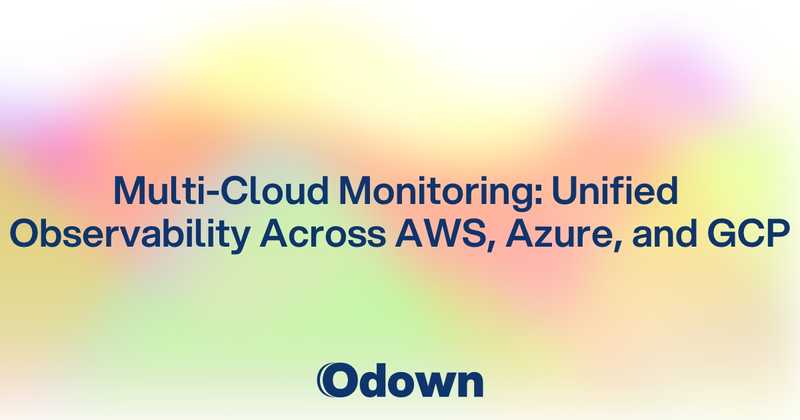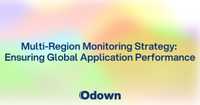Multi-Cloud Monitoring: Unified Observability Across AWS, Azure, and GCP
Your application runs on AWS, your data warehouse lives in BigQuery on GCP, and your machine learning models train on Azure. When something breaks, you're jumping between three different monitoring consoles, trying to piece together what went wrong and where. Sound exhausting? Welcome to multi-cloud reality.
Most companies end up in multi-cloud environments accidentally. They start on one cloud, acquire a company using another, or choose different clouds for specific workloads. Before they know it, they're managing infrastructure across multiple vendors with completely different monitoring tools and approaches.
The problem isn't just operational complexity---it's visibility. When your monitoring is fragmented across different cloud platforms, you lose the ability to see how your entire system is performing. A problem in your AWS infrastructure might be caused by latency issues with your GCP services, but you'll never know if you're looking at each cloud in isolation.
Comprehensive monitoring solutions help bridge these gaps by providing unified visibility across different cloud environments. But building effective multi-cloud monitoring requires understanding the unique challenges and implementing strategies that work across vendor boundaries.
Multi-Cloud Monitoring Challenges: Vendor Lock-in and Data Silos
Every cloud provider wants to keep you in their ecosystem, and their monitoring tools reflect this reality. What starts as convenient native monitoring becomes a trap that makes multi-cloud operations increasingly difficult.
The Vendor Lock-in Monitoring Trap
Cloud providers offer excellent native monitoring tools, but they're designed to keep you using only their services:
AWS CloudWatch excels at monitoring AWS resources but provides limited visibility into non-AWS components. You can monitor your EC2 instances perfectly but struggle to correlate performance with your Azure-hosted databases.
Azure Monitor integrates beautifully with Microsoft services but treats other cloud providers as external dependencies. Your detailed Azure metrics don't help you understand how AWS Lambda functions are affecting your overall application performance.
Google Cloud Operations (formerly Stackdriver) provides comprehensive monitoring for GCP services but limited insight into your AWS or Azure workloads. Cross-cloud correlation becomes manual detective work instead of automated analysis.
Data Silos and Integration Nightmares
Each cloud provider stores monitoring data in different formats, uses different APIs, and provides different export capabilities:
Metric format differences mean you can't easily compare performance across clouds. AWS uses different units and naming conventions than Azure, which differs from GCP. Normalizing this data for unified analysis becomes a significant engineering challenge.
API rate limits and access restrictions make it difficult to build unified monitoring systems. Each provider has different authentication mechanisms, request limits, and data export capabilities that complicate integration efforts.
Data retention policies vary significantly between providers. AWS might retain detailed metrics for different periods than Azure, making historical analysis across clouds nearly impossible without expensive data storage solutions.
Cost Visibility Challenges
Understanding the true cost of multi-cloud operations becomes exponentially more complex when monitoring is fragmented:
Hidden cross-cloud data transfer costs often don't appear in standard monitoring dashboards. Your application might seem efficient when viewed within each cloud, but expensive data transfers between clouds could be consuming your budget.
Resource optimization opportunities get missed when you can't compare equivalent services across different clouds. You might be paying premium prices for services on one cloud while cheaper alternatives exist on another.
Cost allocation becomes nearly impossible when monitoring data lives in different systems with different tagging and categorization schemes. Finance teams can't understand spending patterns without significant manual data consolidation efforts.
Unified Monitoring Architecture: Tools and Strategies for Cloud Agnostic Observability
Building effective multi-cloud monitoring requires architectural decisions that prioritize vendor neutrality while maintaining the depth of insight you need for operational excellence.
Cloud-Agnostic Monitoring Platforms
The foundation of multi-cloud monitoring is choosing tools that work consistently across different cloud environments:
Open-source monitoring stacks like Prometheus and Grafana provide vendor-neutral foundations that work identically across different clouds. You can deploy the same monitoring infrastructure on AWS, Azure, and GCP without vendor-specific modifications.
Third-party monitoring platforms specialize in multi-cloud visibility and provide pre-built integrations with major cloud providers. These platforms normalize data formats and provide unified interfaces that abstract away vendor-specific differences.
Hybrid approaches combine cloud-native tools for deep platform-specific insights with cloud-agnostic tools for unified visibility. You might use CloudWatch for detailed AWS monitoring while feeding summary data to a centralized platform for cross-cloud correlation.
Data Normalization and Standardization
Creating consistent monitoring across different clouds requires standardizing how you collect, store, and analyze data:
Metric naming conventions should be consistent across all cloud environments. Develop standard naming schemes for common metrics like CPU usage, memory consumption, and network throughput that work regardless of the underlying cloud provider.
Tagging strategies need to work across different cloud platforms and monitoring tools. Consistent resource tagging enables unified cost analysis, security compliance, and operational management across your entire multi-cloud environment.
Data pipeline architecture should collect metrics from different clouds and normalize them into consistent formats for analysis. This might involve transforming vendor-specific metrics into standardized formats or building translation layers between different monitoring systems.
Centralized Alerting and Incident Management
Fragmented alerting across different cloud platforms creates operational chaos. Unified alerting systems ensure consistent response regardless of where problems occur:
Alert correlation across clouds helps you understand when problems in one environment are causing issues in another. Network latency between AWS and GCP might manifest as application errors, but you'll only catch this with proper cross-cloud correlation.
Incident response workflows should be consistent regardless of which cloud environment is affected. Your team shouldn't need different procedures for AWS outages versus Azure problems.
Escalation policies need to account for the additional complexity of multi-cloud environments. Different clouds might have different support contracts or response expectations that affect how you handle incidents.
Cross-Cloud Performance Comparison: Latency, Availability, and Cost Analysis
Multi-cloud environments provide unique opportunities to compare cloud provider performance and optimize workload placement based on actual data rather than marketing claims.
Latency Analysis Across Cloud Providers
Network performance varies significantly between cloud providers and between different regions within the same provider:
Inter-cloud latency measurement reveals the real cost of cross-cloud communication. Your application architecture might assume fast communication between services, but if those services run on different clouds, latency could be destroying performance.
Regional performance comparison helps you optimize service placement. The same workload might perform differently on AWS us-east-1 versus Azure East US, even though they're geographically similar.
CDN and edge performance analysis shows how different cloud providers handle content delivery for your specific user base. Performance varies based on your users' locations and the content you're serving.
Availability and Reliability Metrics
Different cloud providers have different reliability characteristics that become apparent only through comprehensive monitoring:
Service-level availability tracking measures actual uptime versus published SLAs. Marketing claims about "five nines" availability matter less than your actual measured experience with different cloud services.
Regional resilience comparison reveals how different clouds handle regional outages and disasters. Some providers might have better cross-region failover capabilities for your specific use cases.
Service-specific reliability analysis helps you choose the right cloud for specific workloads. Database services, compute instances, and storage solutions might have different reliability profiles across different clouds.
Cost Performance Analysis
Understanding the true cost of multi-cloud operations requires analyzing both direct costs and hidden expenses:
Cost per transaction analysis normalizes spending across different cloud environments. The cheapest compute instances don't matter if data transfer costs make your overall solution expensive.
Performance per dollar metrics help you optimize workload placement based on business value rather than just technical performance. A faster service might be worth the additional cost, or a slower service might provide better value for non-critical workloads.
Hidden cost identification reveals expenses that don't appear in basic billing reports. API charges, data transfer fees, and premium support costs can significantly impact your total cost of ownership.
Multi-Cloud Disaster Recovery Monitoring: Failover Detection and Automation
Multi-cloud environments provide excellent disaster recovery opportunities, but only if you can monitor and orchestrate failover procedures effectively across different cloud platforms.
Failover Readiness Monitoring
Disaster recovery systems that aren't regularly tested and monitored will fail when you need them most:
Cross-cloud replication monitoring ensures that your data and configurations stay synchronized across different cloud environments. Replication lag or synchronization failures could leave you with inconsistent systems during disaster recovery scenarios.
Failover procedure testing should be automated and run regularly to verify that your disaster recovery systems actually work. Manual disaster recovery procedures that work in theory often fail in practice due to configuration drift or environmental changes.
Recovery time objective (RTO) and recovery point objective (RPO) monitoring tracks whether your disaster recovery systems meet your business requirements. These metrics help you optimize recovery procedures and identify areas that need improvement.
Automated Failover Decision Making
Effective multi-cloud disaster recovery requires automation that can make failover decisions faster than human operators:
Health check aggregation across multiple clouds provides the data needed for automated failover decisions. Simple ping checks aren't sufficient---you need comprehensive health validation that considers application functionality, not just infrastructure availability.
Cascading failure detection prevents situations where failover to a secondary cloud creates additional problems. Your monitoring should verify that the target environment is actually healthy before initiating failover procedures.
Rollback automation ensures that you can return to primary systems once problems are resolved. Automated rollback requires comprehensive monitoring to verify that primary systems are truly healthy and ready to resume normal operations.
Post-Disaster Recovery Monitoring
The work doesn't end when your systems come back online. Post-disaster monitoring ensures that recovery was truly successful:
Performance validation after failover verifies that your recovered systems are performing as expected. Disaster recovery systems might have different performance characteristics that affect user experience.
Data consistency verification ensures that no data was lost or corrupted during the disaster recovery process. This is particularly important for databases and stateful applications that maintain critical business data.
Capacity planning for recovery scenarios helps you optimize disaster recovery infrastructure. You might discover that your recovery systems need different resource allocations to handle production workloads effectively.
Building effective multi-cloud monitoring requires platforms that understand the complexity of modern distributed systems. Custom metrics implementation strategies provide the foundation for tracking business-specific metrics across multiple cloud environments.
Ready to implement unified monitoring across your multi-cloud infrastructure? Use Odown and gain the visibility you need to manage complex cloud environments with confidence and reliability.



